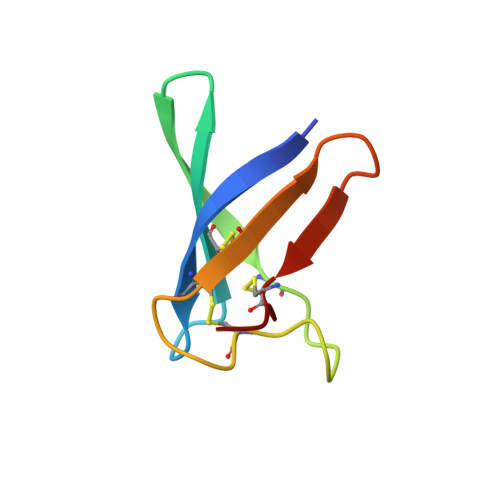Rationally designed antifungal protein chimeras reveal new insights into structure-activity relationship.
Giner-Llorca, M., Del Sol, F.G., Marcos, J.F., Marina, A., Manzanares, P.(2023) Int J Biol Macromol 225: 135-148
- PubMed: 36460243
- DOI: https://doi.org/10.1016/j.ijbiomac.2022.11.280
- Primary Citation of Related Structures:
7ZTF, 7ZTJ, 7ZUT, 7ZVH, 7ZW2 - PubMed Abstract:
Antifungal proteins (AFPs) are promising antimicrobial compounds that represent a feasible alternative to fungicides. Penicillium expansum encodes three phylogenetically distinct AFPs (PeAfpA, PeAfpB and PeAfpC) which show different antifungal profiles and fruit protection effects. To gain knowledge about the structural determinants governing their activity, we solved the crystal structure of PeAfpB and rationally designed five PeAfpA::PeAfpB chimeras (chPeAFPV1-V5). Chimeras showed significant differences in their antifungal activity. chPeAFPV1 and chPeAFPV2 improved the parental PeAfpB potency, and it was very similar to that of PeAfpA. chPeAFPV4 and chPeAFPV5 showed an intermediate profile of activity compared to the parental proteins while chPeAFPV3 was inactive towards most of the fungi tested. Structural analysis of the chimeras evidenced an identical scaffold to PeAfpB, suggesting that the differences in activity are due to the contributions of specific residues and not to induced conformational changes or structural rearrangements. Results suggest that mannoproteins determine protein interaction with the cell wall and its antifungal activity while there is not a direct correlation between binding to membrane phospholipids and activity. This work provides new insights about the relevance of sequence motifs and the feasibility of modifying protein specificity, opening the door to the rational design of chimeras with biotechnological applicability.
- Food Biotechnology Department, Instituto de Agroquímica y Tecnología de Alimentos (IATA), Consejo Superior de Investigaciones Científicas (CSIC), Catedrático Agustín Escardino Benlloch 7, 46980 Paterna, Valencia, Spain.
Organizational Affiliation:

















